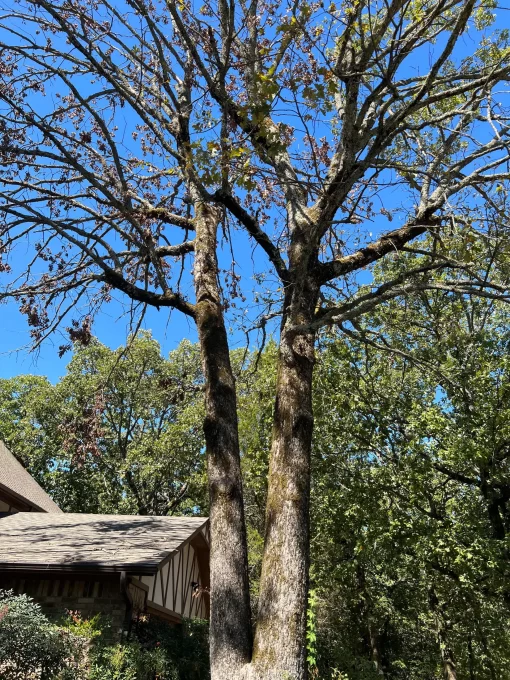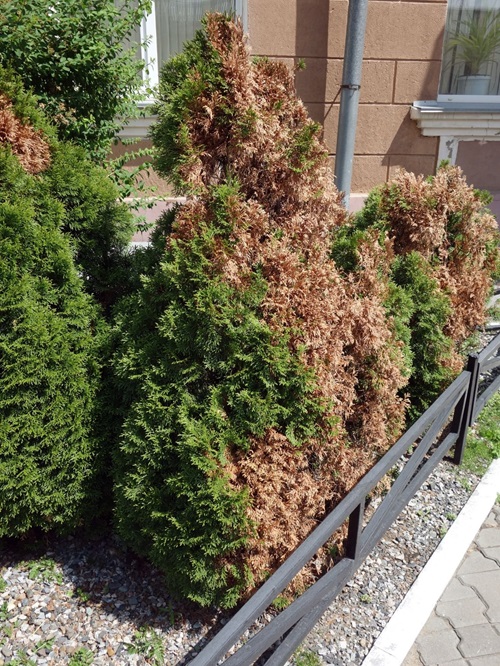Not sure How to Save a Dying Tree in your yard? Here are some expert tips and opinions that’ll help you move in the right direction.
When a tree starts showing signs of distress, it’s not just about saving a plant—it’s about preserving a piece of nature that benefits us all. In this guide, we’ll explore practical and effective steps on How to Save a Dying Tree.
How to Get Free Plants and Seeds | 12 Frugal Gardening Tricks
Identifying Signs of a Dying Tree
1. It Has Way too Many Dying and Unhealthy Leaves
Leaves turning yellow, brown, or any unusual color out of season. Foliage falling before autumn or not sprouting properly in spring is another sign you should look out for.
2. Has Too Much of a Dead Wood on Its Bark
Large cracks or splits in the bark can indicate internal decay. Sections of bark falling off or large bare patches.
3. Shows Very Brittle Branches and Limbs
Branches that are brittle, dry, and snap easily without any living tissue—sudden dropping of branches without any apparent cause.
4. Has a Declining Trunk Health
Large holes or cavities in the trunk can be a sign of internal rot. The presence of fungi, like mushrooms, growing on or at the base of the trunk is also an indication.
5. You Notice Root Issues
Look for exposed, damaged, or decaying roots. Soil heaving up at the tree’s base can indicate unstable or dying ones.
6. Has Canopy Thinning
Sparse leaves or thinning canopy, especially at the top, is not a good sign.
7. Is Full of Insect Infestation
Excessive presence of pests, such as borers, can indicate a weakened or dying tree.
8. Shows No New Growth
Little to no new growth in branches or leaves is a sure-shot indication of an aging or a dying tree.
9. Shows Weak Branch Joints
Weak junctions where branches meet the trunk, potentially leading to breakage. Also, look for brittle branches that are really easy to break.
10. You See It Tilting on the Side
Trees angled more than 15 degrees often suffer damage caused by wind or compromised root systems. It’s rare for large tilted trees to recover fully, and they typically don’t survive long-term.
Signs that Show Your Soil is Bad & You Should Discard It
How to Save a Dying Tree?
1. Determine the Underlying Issue
When addressing the underlying issues of a dying tree, it’s crucial to consider various factors that could contribute to its decline.
- Insects: Insects like bark beetles and borers can severely damage trees. They often bore into the trunk, disrupting the flow of nutrients and water.
- Diseases: Trees can be susceptible to fungal diseases or infections, often manifest as discoloration, unusual growths, or a sudden loss of leaves.
- Drought: Lack of water can cause trees to become dehydrated, leading to wilting leaves and weak branches.
- Extreme Temperatures: Both excessive heat and cold can stress a tree, causing damage to its cellular structure.
- Mechanical Injury: Damage to the trunk or roots from lawnmowers, construction, or other activities can be detrimental.
- Root Damage: Disruption or cutting of roots, especially during construction or landscaping, can severely impact a tree’s stability and health.
2. Prune Affected Branches
Pruning is a key strategy in revitalizing a struggling tree. Remove dead or diseased branches with sharp, clean pruning tools.
Proper pruning enhances the tree’s aesthetic and stimulates new growth. It reduces the burden on the tree and improves air circulation, preventing further stress.
3. Soil Management
The soil in which the tree is planted plays a vital role in its overall health. Ensure the soil is well-draining to prevent waterlogged roots, which can lead to root rot.
- Conduct a Soil Test: This will reveal your soil’s pH level and nutrient profile.
- Interpret Results: Compare the results with the ideal soil conditions for your tree. Key nutrients include nitrogen, phosphorus, potassium, and trace minerals.
- For Acidic Soil: If soil is too acidic (pH below 6), apply lime to raise the pH.
- For Alkaline Soil: If soil is too alkaline (pH above 7), sulfur or aluminum sulfate can lower the pH.
- Organic Matter: Incorporate organic matter like compost or well-rotted manure to improve soil fertility.
- Fertilization: Use a balanced fertilizer tailored to your tree’s nutrient deficiencies.
Aerating the soil can also improve oxygen flow to the roots. Additionally, consider testing the soil’s pH and nutrient levels. Based on the results, provide the necessary fertilization.
One Secret Organic Fertilizer Recipe for Productive Plants
4. Disease Control
If your tree suffers from a disease, implement disease control measures as the arborist recommends. This may include the application of fungicides or other treatments.
Ensure you follow the professional’s advice on timing and application methods. Disease management is crucial to stop the spread and help the tree recover.
5. Pest Management
Pest infestations can significantly weaken a tree. If pests are the culprits, consider employing integrated pest management techniques to control their population.
This may involve introducing natural predators, using insecticidal soaps, or employing eco-friendly methods to protect your tree. Regular monitoring for pests and early intervention are key to success.
6. Protection from Stress and Susceptible Damage
Use physical barriers to protect the tree from mechanical damage – like lawnmowers or trimmers.
39 Bizarre Pest Control Remedies and Ideas for Gardeners
Saving a Dying Tree in a Container
1. Assess the Situation
- Identify the Issue: Look for signs of distress, such as leaf discoloration, drooping, or pests.
- Tree Species Needs: Understand the specific requirements of your tree species, including sunlight, water, and nutrient needs.
2. Examine the Container and Roots
- Root Check: Gently remove the tree from the container to inspect the roots. Healthy roots should be firm and spread out, not circling or congested.
- Rootbound Signs: If the roots are circling or cramped, the tree might be rootbound, a common issue in container plants.
- Container Size: Ensure the container is large enough to accommodate the tree’s root system.
3. Repotting if Necessary
- Repotting: If the tree is rootbound or the soil is exhausted, repotting into a larger container with a fresh potting mix can be beneficial.
- Root Pruning: In some cases, gentle root pruning may be needed when repotting to encourage new root growth.
Support and Care
- Regular watering: Ensure the tree receives sufficient moisture, especially during dry spells. Water deeply and consistently, focusing on the root zone. A soaker hose or drip irrigation can help maintain steady moisture levels.
- Prudent fertilization: Overfertilization can harm the tree, so follow expert guidance.
- Monitoring and patience: Keep a watchful eye on the tree’s progress. Recovery takes time, and patience is key. Be prepared to adjust your care regimen as needed.
Additional Tips
- Mulching around the tree’s base with organic matter like wood chips or compost can help retain moisture and enhance root health.
- Apply beneficial mycorrhizal fungi to the tree’s root zone. This symbiotic relationship enhances the tree’s ability to absorb water and nutrients.
- Support the tree with staking if it has lost its stability due to structural damage.
Here are Some Unconventional Gardening Tricks to Become a Pro Gardener
Conclusion
Consulting an arborist is essential for a definitive diagnosis. They can offer expert advice on whether the tree can be saved or needs to be removed for safety reasons.
Safety Note: A dying tree can be a hazard. Don’t attempt to remove large trees yourself; always seek professional help.




